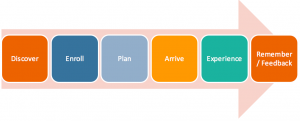There are phrases like Big Data and Cloud Computing that were not in our regular lexicon 20 years ago. In that sense experience is not literally a new word, but when it comes to the way many people are using it, it might as well be.
As a word, “experience” has been around since at least the 13th century tracing back to the latin word for “try” and since then it seems most languages including Russian (опыт), Chinese (经验), Icelandic (reynsla), to German (Erfahrung), Dutch (revering), Italian (esperienza), and every other language I Googled, have a word for it.
I considered comparing the transformation the word experience is going through to eclosion – the process by which a caterpillar goes through in transforming into a butterfly. But even that doesn’t work, because the transformation is really one where the word experience was an almost abstract and intangible but deeply personal notion (in ways a caterpillar is not), in much the way many of us use the word love. Increasingly experience is being used to convey something very concrete, real, and measurable. Some of this is rooted in the opportunity to have richer and more personal context for experiences of all kinds and Robert Scoble’s book Age of Context was ahead of its time with some of its insights on what people are doing with technology to amplify context and improve experience.
These days I see and meet organizations that have people and teams with the word “experience” in their titles and having been a big part of efforts to create “next generation experiences” for Disney customers and “customer experience transformation” efforts for others – it is clear that organizations see that designing and creating new customer experiences is the next frontier, and data and information are at the core of this.
Customer experience journey maps are an increasingly common tool to inform the prioritization of opportunities related to these customer experience transformations. This is one place where experience already means much more than “try” in the traditional sense. Common steps in experience journey mapping include:
-Discover (how they find out the experience is possible or an option for them)
-Enroll (if they need to sign up to participate in the experience this is a step)
-Plan
-Arrive
-Experience (this is when they immerse themselves in whatever it is they want to do, online or physical. You might put the word “try” here if you prefer)
-Remember (whether looking at photos of their experience, or completing a survey about their doctor visit, all of that fits in this segment)
In some cases experience journey mapping is an ideal place to start – in other cases it is both risky and ill-informed.
We are all familiar with the old adage of getting from point A to point B. Many people talking about experience definition and change are solely focused on point B – where they want to be, not actually stopping to consider that they don’t have much information about point A (where they are right now). Important questions to ask include:
-Who is the customer?
-What is the customer lifetime value for each customer?
-What are the meaningful customer segments?
-Which segments are growing and shrinking and do we know which we should be more excited or concerned about?
-Why do they choose us when they have an experience with us? Is it our price, speed of service, product selection, the way we recognize them for their loyalty, or something else?
Because the information most organizations have about their customers is transactional – that is, what they have purchased, as one example, there is very little information about the information around the transaction – why they chose that transaction, what other things they considered, how long they thought about it, whether it was meaningful to them, and so on.
Experience data is in many instances the data between the transactions and touch points (this is a good piece in HBR by Alex Rawson, Ewan Duncan, and Conor Jones where they elaborate on case studies about delving into the data between the touch points and what it can reveal in terms of actionable intelligence). From that data, an organization can create information, and from that information patterns emerge. That’s when you unmask your point A, and from that point A, it’s much more practical to start defining a point B.
If you are part of this data-driven experience world, I encourage you to start collecting data so you can get information from that data before you get too bold in your experience transformation bets.
The bigger point is to realize that the way people are using the word is in itself transforming, and people who continue to treat experience as an intangible abstract notion like love are missing the change already underway, and clinging to transactional data about customers is not enough.

Leave a Reply